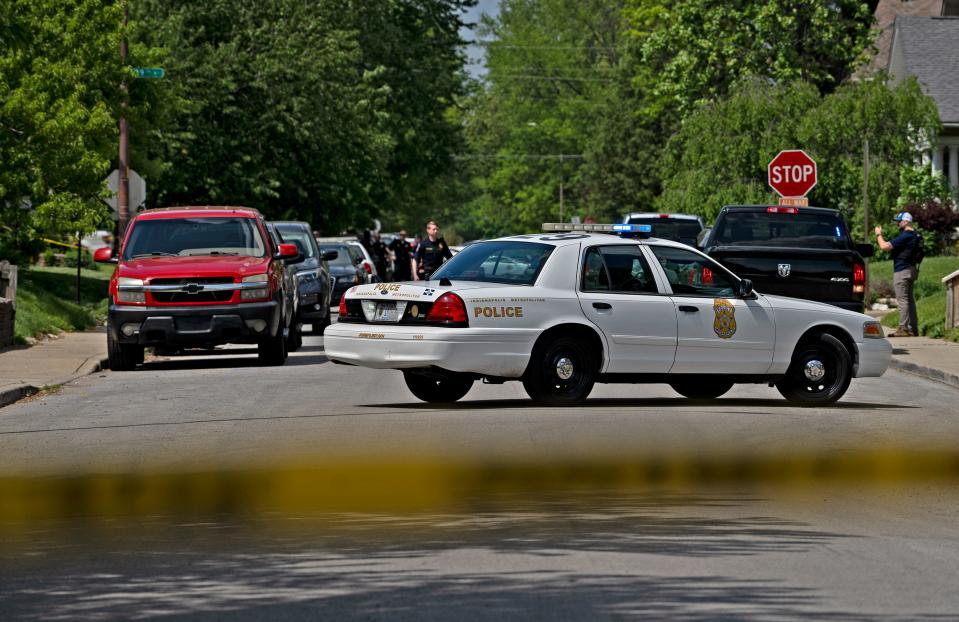Briggs: Indianapolis' police union keeps getting paid and trashing the city anyway
- Oops!Something went wrong.Please try again later.
The Indianapolis police union is a malignant force. It capitalizes on tragedies to warn of more, escalating tragedies unless the union gets what it wants.
Every year, the city gives the union what it wants.
The union's response? It trashes Indianapolis as an uninhabitable wasteland where criminals rule, aided by sympathetic judges, and where police are helpless to intervene.
That's the message of a billboard the Indianapolis Fraternal Order of Police erected last month along Interstate 70. The billboard reads: "We can't help if we're not there."
It's a spiteful, disingenuous gambit by the police union to make an issue of understaffing during a contract year. Yes, it's true, Indianapolis has fallen hundreds of officers short of the city's hiring target. As the Indianapolis FOP well knows, it's also a national problem with no apparent solution.
As CNBC reported, officer resignations in 2022 were 47% higher than they were in 2019. That's the year before COVID-19, the murder of George Floyd and anti-police protests, some of which turned violent.

Staffing is not just a problem in big cities. Small towns are disbanding their police departments because of the officer shortage, CNBC reported. Policing, as a profession, is in decline. Indianapolis can't hire people who don't exist or retain people who've resolved to move on with their lives.
The city is trying, though. Indianapolis last year raised first-year officer pay to $72,000. To put that into perspective, the national median wage for patrol officers is $72,280, per the Bureau of Labor Statistics. An entry-level officer in Indianapolis is already earning more than about half of all police in America.
That isn't enough to meet full staffing. Indianapolis as of last month was 266 officers below the budgeted staff of 1,743, IndyStar reported. That's why the city announced it was rerouting American Rescue Plan Act money to retention bonuses.
Indianapolis is not only bending over backwards on money and quality-of-life measures, but also wish-list items bordering on frivolity. For years, the Indianapolis FOP called for adding a gunshot detection system in Indianapolis despite research showing it's ineffective and local police officials saying it wasn't a good use of money.
Guess what? Mayor Joe Hogsett in 2021 announced a million-dollar-plus investment in a gunshot detection pilot despite already knowing what the program would reveal. Indianapolis in March decided it would not move forward with a gunshot detection program (after, oddly, having sought a contract with ShotSpotter) because the pilot proved ineffective and unreliable.
Rather than accepting the city's findings, Rick Snyder, president of the Indianapolis FOP, called the decision to avoid wasting millions more "short-sighted and flawed."
Indianapolis has shown it will put its officers among the best-compensated in the nation and light money on fire to appease the union. It's never enough. Snyder sits at his keyboard not touting his victories, but rather sharing hyperbolic social media posts about the latest shootings and stabbings as more proof of "#SurgingViolence," as he puts it.
Except, the violence is not surging. Not anymore.
Homicides are plummeting by 20% across the U.S., the fastest pace in decades, The Wall Street Journal reported. Just like Indianapolis homicides rocketed with the tide during the pandemic, homicides are now falling here with the national tide.
It's unsettling how much we still don't understand about why violent crime soared in 2020 and then started falling for no apparent reason. It's hard to give Hogsett much credit for fixing anything when Indianapolis is more or less bobbing along with other cities across the U.S.
The national trends call into question whether any of Hogsett's policies have mattered. Hogsett over the years has introduced a series of new tactics and initiatives and buzzwords. Most of all, though, he's backed trucks full of money up to the police department.
Indianapolis police spending has risen by more than 42% to $324 million since Hogsett took office in 2016. With so little to show for all those millions, perhaps it's time for the city to slow down and negotiate a little harder on the next FOP contract.
The FOP would frame anything other than another colossal expansion of the police budget in apocalyptic terms, arguing that officers are going to walk away en masse and the streets will flow with blood. But the union has been saying those things, anyway, even as it has repeatedly gotten everything it's sought — and more, in some cases.
If Snyder wants to shout from the interstates that Indianapolis is a terrible place to live or visit, let him. Just don't reward him for it.
Contact James Briggs at 317-444-4732 or james.briggs@indystar.com. Follow him on X and Threads at @JamesEBriggs.
This article originally appeared on Indianapolis Star: Indianapolis FOP's contract gambit hypes tragedy to get more money

